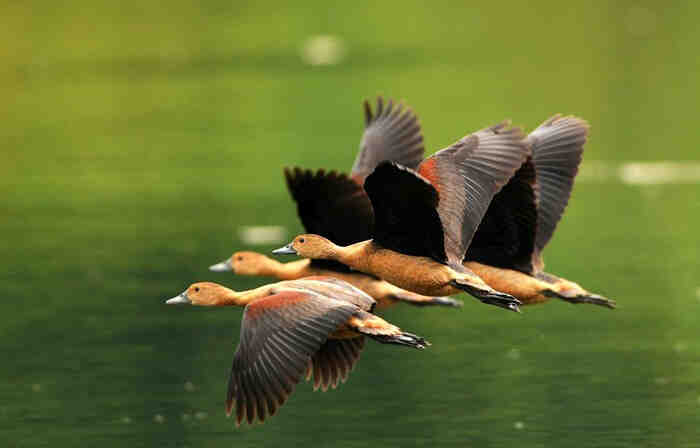Dendrocygna javanica
IUCN
LCBasic Information
Scientific classification
- name:Dendrocygna javanica
- Scientific Name:Tree duck, Ny duck, Screaming duck,Dendrocygna javanica,Lesser Whistling-duck,Lesser Whistling Duck
- Outline:Waterfowl
- Family:Anseriformes Anatidae Dendroductus
Vital signs
- length:36.8-41.7cm
- Weight:100-600g
- lifetime:No textual research information is available
Feature
Weak in flight, strong in diving
Distribution and Habitat
It is distributed in Bangladesh, Bhutan, Brunei, Cambodia, China, India, Indonesia, Lao People's Democratic Republic, Malaysia, Myanmar, Nepal, Pakistan, Singapore, Sri Lanka, Thailand, Vietnam.
Travellers: Israel, Japan, Maldives, Oman, Taiwan Province of China.
It lives in ponds, lakes, and other waters rich in plants, and also appears in swamps and ponds and streams with vegetation around them. They usually prefer to hide in tall grass or under lotus leaves, and can also be found in groups on water, but usually avoid open lakes.
Appearance
The upper body is mainly dark brown, the tail is covered with feathers, the lower chest and abdomen are chestnut, the eyes have narrow yellow eyes, the feet are longer, the mouth and feet are black, and the neck is longer. It looks like a goose. When flying, the chestnut red wings and tail cover are in sharp contrast to the black flight feathers and tail feathers, and the feet are far out of the tail. Both sexes are similar. The forehead is light brown. The head and the pillow are brown, with dark brown lines, forming a black band extending from the pillow to the nape of the neck. Back and shoulders dark brown, with brown or brownish gray feather margin. The waist is black, sometimes with narrow brown-gray plumage. The tail is black, the upper tail cover and the middle and small wing cover are chestnut red, the large cover and the flying feathers are dark brown. The cheeks and front neck are gray yellow, the chin and throat are nearly white. The upper thorax is yellowish-brown, the low
Details
The Lesser Whistling-duck is a small and medium-sized duck with no subspecies.

Chestnut duck breeds mainly in the south of China. It is a summer migratory bird in the middle and lower reaches of the Yangtze River. In Yunnan, Guangxi, Guangdong and Fujian regions, some are resident birds, some are summer and winter migrants. It is a resident bird on Hainan Island. Taiwan is a lost bird. Long distance migrations are not common.
Chestnut ducks stand upright when they rest, and often a few of them look around from time to time, and take off first when people or enemies are near, followed by other trees and ducks. Extremely alert. Often in groups of a few to dozens of activities and foraging, there are many to hundreds of large groups. It is weak in flight and can't fly as fast as other ducks. Making a light, high-pitched whistling sound while flying. Also good at swimming and diving, and diving ability is very strong, when the vine can not fly when diving into the water. A dive can last up to ten minutes. During the hot day, they often sleep and rest in reeds or other tall grass patches. When food is abundant and undisturbed, they often inhabit a fixed place and generally do not change their habitat. They don't even migrate long distances
Chestnut ducks can feed both on the surface and under water, and sometimes on the ground near water to forage for grass. The food is mainly plant food such as rice, crop seedlings, grasses and aquatic plants. They also eat animal foods such as insects, snails, mollusks, frogs and small fish. Usually at dusk, they fly in groups of a few to a few dozen to feed in nearby rice fields. Return to day waters before dawn.
The breeding season of chestnut ducks is from May to July. Nest in grass on the ground covered with trees or plants or in reed swamps and tree holes. Courtship and mating take place in the water. Before mating, the male and female ducks swim together. The male ducks continuously dip his beak towards the female, and the female ducks maintain an upright position. The nest is composed of grass leaves and stems, and is 25 cm in diameter and 6 cm in height. Each brood lays 8-14 eggs, generally about 10, and the eggs are white. The eggs are incubated by both sexes for 27-30 days.
Because chestnut ducks mainly feed on rice and often integrate into large groups, causing certain harm to crops, when the population is large, they were once regarded as harmful birds by local farmers to hunt a large number of ducks, coupled with environmental pollution and heavy use of pesticides, resulting in a significant decline in the population of this population is extremely rich and common ducks. In some places, such as Japan, it may be extinct, and populations in China are rare. According to the 1990 Asian midwinter waterbird survey organized by the International Waterfowl Research Bureau, there are 37,857 in India, 40,533 in Thailand, 7,846 in Bangladesh, 2,300 in Nepal, 7 in 2 families in Sri Lanka, and 3,377 in Myanmar. The total population is estimated to be about 100,000.
The distribution of chestnut ducks was recorded in the middle and lower reaches of the Yangtze River. Since 1980s, the distribution area of chestnut ducks has been shrinking to the southwest of China, mainly due to the change and destruction of habitat environment. Distribution has been recorded in the coastal islands of Guangdong, Hainan and Fujian.
Listed in the International Union for Conservation of Nature Red List of Threatened Species (IUCN) for 2016 ver 3.1 - Not Threatened (LC).
It was included in the List of Beneficial Terrestrial Wildlife under State Protection or of Important economic and scientific research Value issued by the State Forestry Administration of China on August 1, 2000. (Note: Item 45)
Listed in China's "National Key Protected Wildlife List" (February 5, 2021) Level 2.
Protect wild animals and eliminate wild meat.
Maintaining ecological balance is everyone's responsibility!








